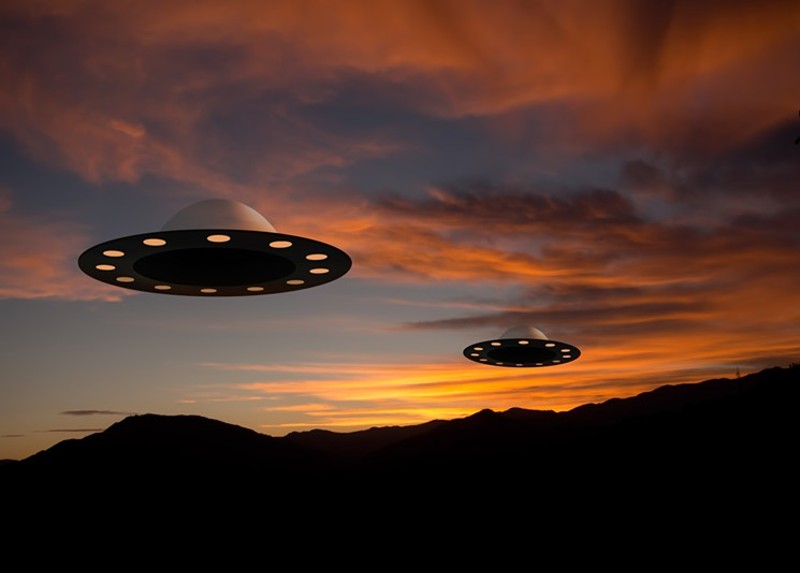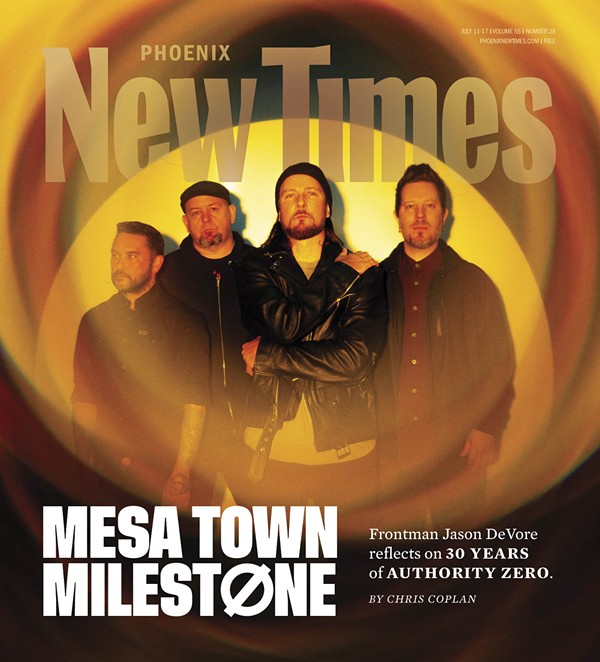In case you hadn’t heard, Arizona is a popular tourist destination for intergalactic visitors.
The state consistently ranks among the top areas for reported UFO sightings. In fact, there have been more than 3,000 recorded sightings in Arizona since 1950, according to the Davenport, Washington-based National UFO Reporting Center.
And it isn't just the widely reported 1997 mass sighting of the so-called Phoenix Lights. Historically, some of the strangest, unexplained alien encounters occurred right here in Arizona.
"Arizona has always been a hotbed for UFOs, and the Phoenix Lights really proves that," says UFO hunter Jeff Willes, who runs the website UFOsOverPhoenix.com.
Willes calls himself "the original UFO hunter." Since 1995, the shaggy-haired landscaper has been observing Phoenix skies for hours a day in search of photographic evidence of unidentified flying objects and proof of alien activity.
In consultation with Willes and other UFO enthusiasts, Phoenix New Times has compiled the top five alien encounters in Arizona.
Without further ado...
The Rhodes ‘Disc’ Photos (1947)
On July 7, 1947, a 30-year-old Arizona man took one of the first and most famous photos of flying saucers in the skies over Phoenix.It was about 4 p.m. when William Rhodes stepped out of the back door of his Phoenix workshop after a summer thunderstorm. The sound of an approaching jet caught his attention, but when he looked to the sky, he saw nothing.
Seconds later, an elliptical gray disk appeared, hovering silently above the horizon toward the northeast. Rhodes later estimated it to be 20 to 30 feet in diameter, with a cockpit and a tail. The object hung about 5,000 feet above the ground before suddenly spiraling downward, dropping 2,000 feet in seconds.
Rhodes ran inside, grabbed his camera, and got off two shots as the disc flew upward toward the clouds. The craft took off at speeds he estimated to be between 400 and 600 miles per hour, then disappeared over the western horizon.
Rhodes told a local reporter in 1998 that after his photo was published in the Arizona Republic, a government agency had asked to "borrow" the negative but never brought it back.
"That is the very first picture of a cylinder-shaped UFO ever — that's really the significance behind that sighting," UFO hunter Jeff Willes says. "Plus, that was one of the first Arizona sightings to be captured on photograph."
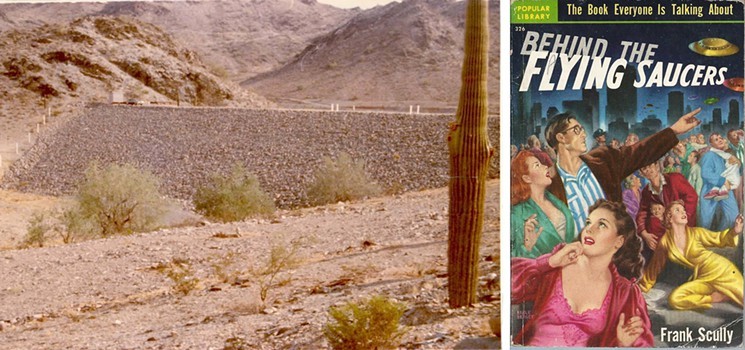
Left: a photo from a 1975 Army Corps of Engineers inspection report on the Dreamy Draw Dam. Right: the paperback edition of Frank Scully's "Behind the Flying Saucers," published in 1951.
Maricopa County Flood Control District
Dreamy Draw UFO Crash (1947)
The year 1947 was huge for extraterrestrial activity. Not only did the granddaddy of all reported UFO crashes occur in Roswell, New Mexico, in July of that year, but a few months later, Phoenix was the site of a purported UFO crash.In October 1947, a 36-foot spacecraft is said to have hurled itself into the sand-strewn mesa of the Dreamy Draw, a desert park next to Piestewa Peak, just south of Highway 51.
According to published accounts, the vessel came to rest at the base of Squaw Peak Mountain, adjacent to downtown Phoenix.
Legend has it that the government built the "useless" 455-foot-long Dreamy Draw Dam in order to hide the wreckage of the spacecraft. (The official version: The dam was built in 1973 for flood-control purposes.)
As related in a 1950 book called "Behind the Flying Saucers," the tale features two men who pulled a couple of dead alien corpses from the wreckage and stored them in a freezer until the army picked them up. Another version has the spacecraft crashing miles away, in Cave Creek or Paradise Valley.
"What’s amazing and significant is that there were two UFO crashes, one in Roswell and one in Phoenix, within fairly close proximity, that occurred in the same year," Willes says. "As far as the dam being built over the crash site, that’s a possibility, but I don’t see why the government wouldn't just remove the wreckage and there wouldn't be anything left but desert landscape."
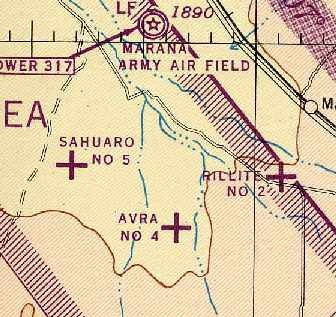
A 1945 U.S. government Phoenix Sectional Chart showing Marana Army Air Field and Marana Auxiliary Army Airfield No. 2, No. 4, No. 5
Chris Kennedy/Public domain
Marana Air Base Sighting (1952)
While waiting for a radio transmission from one of his students, a pilot instructor at the U.S. Air Force base at Marana (now Pinal Airpark), northwest of Tucson, noticed a bright star in the morning sky at about 7:45 a.m. on April 3, 1952.The instructor didn't say anything about it, but soon two of his colleagues also pointed out the unusual mass hovering in place, according to published reports. Another pilot took off from the base in a plane to get a better look at the strange metallic object.
About 45 minutes after the instructor noticed the UFO, it vanished. "It was real bright and shone like polished aluminum. I have been flying for 25 years and I have never seen anything like it," he said at the time.
There were no military reports about balloons or other craft in the vicinity. To this day, the incident remains unexplained.
The airbase sighting is among those listed in Project Blue Book, the Air Force’s infamous, top-secret UFO study, which compiled 12,618 sightings across the nation from 1947 to 1969. The 130,000-page report includes hundreds of reports of mysterious flying saucers and glowing spheres over Arizona.
"Project Blue Book was pretty much the government’s attempt to explain away the sightings," Willes says. "And for sightings they couldn’t find a way to explain away, they labeled them as 'unexplained' — like it was no big deal. And then they never told the public what they discovered."
Travis Walton and ‘Fire in the Sky’ (1975)
Retired Arizona logger Travis Walton has spent the past 40 years haunted by the skepticism and publicity that surrounds one of the best-known alien abduction stories in history.On Nov. 5, 1975, while working with a logging crew, the 22-year-old Walton noticed a metallic golden disc hanging in the sky, 15 feet above a tangled pile of logs in a dense forest area in Northern Arizona, near Snowflake.
Walton approached the disk, which began to wobble from side to side. Suddenly, a blue-green light emanated from the craft, striking Walton and lifting his body in the air. His terrified colleagues, who witnessed the abduction, drove off in a pick-up truck.
For five days Walton was missing, spurring a nationally publicized manhunt. When he reappeared, naked and disoriented, he told a chilling tale of a spaceship and silent, big-eyed extraterrestrials.
Walton claimed that when he regained consciousness aboard the craft, he found himself surrounded by squat, bald creatures.
"I was looking squarely into the face of a horrible creature. It looked steadily back at me with huge, luminous brown eyes the size of quarters," he writes in "Fire in the Sky," his book about the experience. "I looked frantically around me. There were three of them!"
He claimed to remember little else, as one of the creatures placed a helmet over his face and he blacked out.
For years, Walton has been plagued by hostile investigators, an exploitive press, and debunkers.
"In the '70s, there were several other abduction stories," says Willes. "The Travis Walton case trumps the other cases because there were several witnesses — who passed lie-detector tests — that saw him get beamed up into the UFO."
In 1993, the film "Fire in the Sky" was released to theaters.
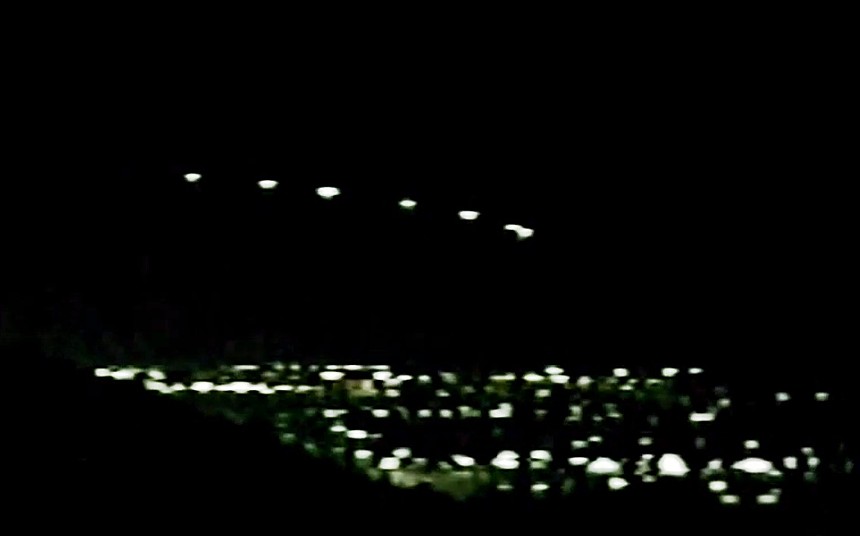
A screengrab of camcorder footage of the V-shaped formation of lights that appeared over the Valley on March 13, 1997.
Screen Grab
The Phoenix Lights (1997)
As most Arizonans know, the otherworldly event that elevated Phoenix's prominence in the annals of UFO lore was the Phoenix Lights — one of the largest mass UFO sightings of all time.On March 13, 1997, a string of glowing orbs hovered over Paradise Valley skies. For three hours the huge, V-shaped formation passed silently over a 300-mile corridor from the Nevada line through Phoenix to the northern edge of Tucson.
The lights were witnessed by thousands and photographed by hundreds, who had been watching the skies that night to catch a glimpse of a passing comet.
The military later claimed the wedge of lights was nothing more than flares dropped over the Valley during a training exercise.
But witnesses — including then-Arizona Governor J. Fife Symington III — were convinced they saw an otherworldly craft. "It couldn't have been flares because it was too symmetrical," Symington would tell Prescott Daily Courier reporter Leslie Kean 10 years later. "It had a geometric outline, a constant shape."
Few reported UFO sightings have generated more passion, publicity and debate than the Phoenix Lights.
Dr. Lynne Kitei, a local physician who witnessed the phenomenon and produced a documentary about it, says the incident mystifies UFO researchers to this day.
"Much has happened since the historic and still-unexplained March 13, 1997, mass sighting, propelling the Phoenix Lights into the international limelight as the most witnessed, most documented, and most important mass anomalous aerial events in modern history,” she tells New Times.
Jeff Willes says the Phoenix Lights was impossible for the government to conceal.
"The Phoenix Lights is Arizona's biggest UFO story," he says. "Thousands of witnesses saw this V-shaped object that flew all across the state. There still hasn’t been a UFO sighting like that in UFO history."
(This article originally appeared in 2016 and has been updated.)

